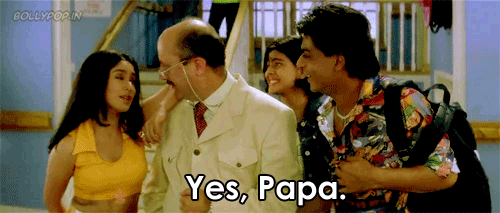
by Duriba Khan
This post was originally published on our partner website India.com:
Parents are an essential part of growing up: they nurture us, teach us our first words, and make us the people we are today. However, South Asian parents are little special—they have a unique way of doing things. After speaking to friends and family, I’ve compiled this list of 10 things that only desi parents manage to teach us.
1. “No boyfriend until marriage.”
All throughout my life, dating has been a big no-no. If I as much as complimented Shah Rukh Khan’s man bun, my mother just decided to politely remind me that I couldn’t have a boyfriend until I got married. The. Logic.
2. The yogurt container isn’t just for yogurt.
How many times has it been that you need yogurt to make yourself a delicious parfait after a long day and you suddenly spot a yogurt container in the fridge? As you giddily reach for it and uncap it, you are instantly greeted with food—just not yogurt.
From achars, leftover palak paneer, to butter chicken—literally anything but yogurt. To make matters even worse, sometimes they’ll be multiple containers and you’ve not ventured into an episode of “Dora the Explorer” on her hunt for yogurt. Where is that map when you need it?
3. Any career that isn’t “doctor” basically means you’re throwing your life away.
Career choices are a hot topic my desi friends and I constantly bond over. While growing up, we were all certain that we wanted jobs as doctors. However, now that we’re all older, we’ve decided to venture into fields like engineering, law, journalism, and social work. For some reason, our parents can’t seem to let go of the people we used to be, or rather the people we were brainwashed into believing we wanted to be—which is likely why your Dad still tells his friends you’re pursuing medicine when you’re an economics major. They speak of it like “it’s just a phase,” or a “side job” you’re working on until medical school, or—the ever favorite excuse—a jinn/shaytan/devil has possessed you, “kisi ki buri nazaar lag gayi” they’ll say and now you are in need of an exorcism to bring you back to “the right path.”
4. Almonds and spoonfuls of yogurt are more effective study tools than tutoring.
Does anybody else realize that yogurt and almonds aren’t going to help you with organic chemistry? You know you still grab some before an exam, any way, though—but why? Let’s call it the placebo effect, studying, or brainwashing—it seems to have worked so far, right?
5. Who needs style? Because your dad insists that he won’t have his son looking like a “bastard hippie.”
Number one rule: If you’re a desi kid, make sure you look like one. Ladies, forget pixie cuts, dying your hair various colors, baggy jeans, or basketball shorts. Gentlemen, forget skinny jeans, man buns, or literally anything trendy—unless you wanted to be buried under your dad’s tomato garden. For the sake of your parents—and your own well-being—stick to polos and long, black hair; because according to our parents, style and trends are insignificant.
6. You can never study enough. “Beta, go study. Kya tumhara blood test nahi hai?”
As a desi kid, perhaps the most stereotypical misconception people have about you is that you’re insanely smart. Even though this may or may not be true, the fact stands that your parents firmly believe one can never study enough—no matter the occasion.
7. Violence and gore are totally okay. But one kissing scene…
Watching Hollywood movies with your family is always a gamble. With desi parents, everything is basically unpredictable—for example, when people get massacred on screen with gallons of blood pouring out, parents don’t flinch one bit. But as soon as two actors gaze lovingly into one another’s eyes… the awkwardness ensues. Someone will find the courage to change the channel, others dart to “use the restroom,” the slow ones among us result to finding something on our phone screens SERIOUSLY interesting, and the younger children are demanded to shut their eyes. In fact, at age seventeen, I still covered my eyes at the sight of people kissing.
8. You can never send too many “Where are u” text messages.
As a desi kid, it’s super important that whenever you leave the house (even if it’s just the library) you keep your parents posted.
All. The. Time.
On the daily, I probably get about five of these text messages. But don’t get annoyed: all your parents are trying to do is make sure you don’t get kidnapped—or spend any time with someone of the opposite sex.
9. Those goodbyes at parties last longer than Kim Kardashian’s marriage.
So first off your mother dragged you to yet ANOTHER dawat (the fourth one or something this week), and then when you got bored of pretending to enjoy playing with some random little girl, took about forty Snapchat selfies (one of which you posted), and grinned and bared through an Aunty’s comments about your weight, it is finally time to leave.
Unfortunately, your joy only lasted for so long: you stood in the doorway for about 30 minutes, then the front yard for another 20 minutes and now you’re in the backseat politely waving while an Aunty leaned into the passenger side window having a very intense discussion about peas. And just like that, another hour (or two) has passed.
10. No matter what they say, they’ll always love you.
But despite the technicalities and quirks, your parents will always love, cherish and respect you. Even though your Dad hasn’t told you he loved you since you were about five, and even though you feel like your mother is embarrassed by you—they will always love you, regardless of your haircut, major, or inability to text them back.
 Duriba Khan, or “D-Dawg,” is a sixteen-year-old blogging, vlogging, photographing, filmmaking, sketching geek who enjoys long, romantic walks to the refrigerator. She is half-Pakistani and half-Indian and currently resides in Austin, Texas. Duriba also feels uncomfortable writing about herself in the third person. For more of Duriba’s work, check out her blog.
Duriba Khan, or “D-Dawg,” is a sixteen-year-old blogging, vlogging, photographing, filmmaking, sketching geek who enjoys long, romantic walks to the refrigerator. She is half-Pakistani and half-Indian and currently resides in Austin, Texas. Duriba also feels uncomfortable writing about herself in the third person. For more of Duriba’s work, check out her blog.




